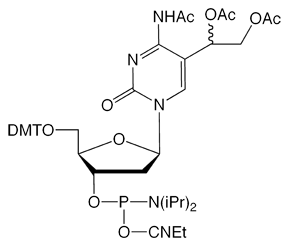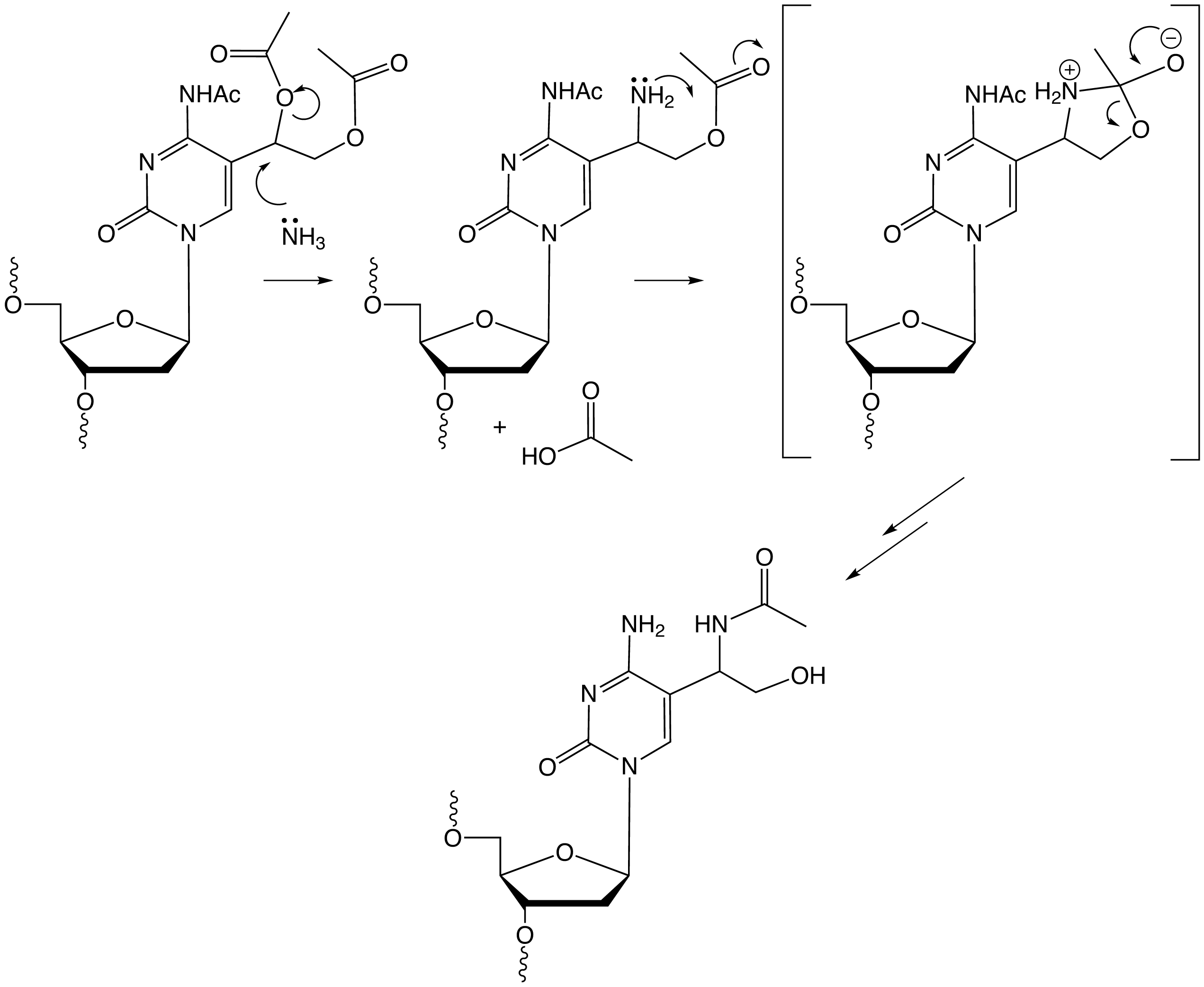5-Formyl-dC appears to be a crucial intermediate in the demethylation pathway of 5-methyl-dC where it is recognized and excised by Thymidine-DNA glycosylase base-excision repair enzymes, leading to the insertion of a non-methylated deoxycytidine.1
 (1)
(1)
Structure of 5-Formyl-dC
While 5-Formyl-dC (1) has been a popular product, its use is complicated by a side reaction which occurs when deprotecting the oligo in ammonia or methylamine solutions. Rather than attacking the carbonyl of the acetyl protecting group, the nucleophile attacks the carbon, displacing acetate as a leaving group. Now vicinal to the second acetyl protecting group, it quickly attacks the carbonyl, leading to the formation of a substituted N-acetamide, rather than the desired glycol. The proposed mechanism is shown in Figure 1.

FIGURE 1: Proposed Mechanism for Impurity Formation with Ammonium Hydroxide
One solution to this problem is to use hydroxide as the nucleophile rather than ammonia or methylamine. This way, even if the acetate displacement occurs, it is a transparent substitution that still affords the desired 5-glycolyl-deoxycytidine, which, upon oxidation with sodium periodate, yields the desired 5-formyl-dC. Typically, 0.4 M NaOH in MeOH/water 4:1 (v/v) for 17 hours at room temperature is used to deprotect the oligo.
However, difficulties can arise. The first thing to consider is the choice of protecting groups for the dG and dC bases. Quite surprisingly, dimethylformamidine (dmf), a popular protecting group for guanosine, is remarkably resistant to the sodium hydroxide solution. While an isobutyrylprotected dG is cleanly deprotected in 17 hours, the dmf group requires over 72 hours at room temperature.
In addition, if benzoyl-protected dC is used, nucleophilic displacement of benzamide can occur due to hydroxide attack of the C4 carbon, leading to deamination and a dC to dU mutation. This can be avoided if acetyl-protected dC (Ac-dC) is used during synthesis.
A final concern is that the yield of oligos can be highly variable when using 0.4 M NaOH in MeOH/water for deprotection. The CPG will tend to fuse to a solid cake in the bottom of the vial of larger-scale syntheses and the oligo will tend to precipitate onto the CPG. However, we found that by first briefly sonicating the vial to break up the CPG, pipetting off the supernatant and then rinsing the CPG with water, will consistently give good oligo yields.
Note, the use of sodium hydroxide necessitates a desalting step. This can be accomplished, while simultaneously purifying the oligo, by using a Glen-Pak™ purification cartridge. An optimized protocol (for a 1 μmole synthesis scale or smaller) is given below. With this procedure, multiple incorporations of the formyl-dC can be introduced into an oligo cleanly.
Improved Protocol for Deprotection and DMT-On Glen-Pak Purification of Formyl-dC
1) Make a fresh solution of 0.4 M NaOH in MeOH/H2O 4:1 (v/v).
2) Treat the column with 3 mL of 10%DEA in ACN for 2 minutes, pushing the solution back and forth occasionally. Rinse with ACN and dry the CPG.
3) Transfer the CPG to a vial and add 1 mL of 0.4 M NaOH in MeOH/H2O 4:1 (v/v).
4) Allow to react for 17 hours at room temperature.
5) Briefly sonicate the vial to break up the CPG.
6) Pipette off the supernatant and transfer to a clean vial. Rinse the CPG with 250 µL of water and combine with the cleaved oligo.
7) Dilute to 10 mL with 100 mg/mL NaCl in water.
8) Load onto a prepped Glen-Pak™ cartridge (60-5200-xx) fitted with a 10 mL syringe and purify using the standard protocol but beginning with the Salt Wash Step – i.e., the 2 mL rinse with 100 mg/mL NaCl containing 5% ACN.
9) Dry the purified oligo and dissolve it in 250 µL of water. Chill at 4 °C
10) Make a fresh solution of 50 mM NaIO4 (2.7mg per 250 µL water)
11) Add 250 µL of 50 mM NaIO4 to the chilled oligo solution, briefly vortex and return it to the refrigerator. Keep at 4 °C for 30 minutes.
12) Add 3 mL 0.1 M TEAA and desalt on a prepped Glen-Pak cartridge.
Reference
1. A. Maiti, and A.C. Drohat, J Biol Chem, 2011, 286, 35334-8.
Product Information